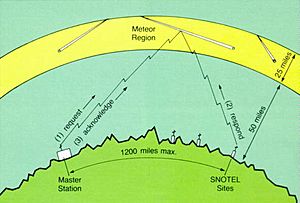Meteor burst communication facts for kids
Meteor burst communication is a special way to send radio messages. It uses radio waves that bounce off tiny trails left by meteors. These trails are made when meteors enter Earth's atmosphere. This method is also called Meteor scatter communication.
Meteors are small pieces of rock that float in space. Many meteors enter Earth's atmosphere every day. Most of them burn up high in the sky. If a very large one hits the ground, it's called a meteorite. Most meteors are actually just tiny specks of dust. When they zoom into the atmosphere, the air rubbing against them creates a lot of heat. This heat causes electrons to break away from the meteor's atoms. This creates an "ionized trail," which is like a temporary, electrically charged path. This trail can reflect radio waves, just like a metal wire would.
The meteors useful for this type of communication are very small. They weigh between one thousandth and one hundredth of a gram. Smaller meteors don't make a strong enough trail. Larger ones don't happen often enough to be useful.
How Meteor Burst Communication Works
The ionized trail from a meteor usually lasts for several seconds. During this short time, messages can be sent between two radio stations. These messages travel very fast. They can be about 200 times faster than messages sent using regular shortwave radio. For example, a teletypewriter might type several lines of text during just one meteor burst!
The two stations that want to talk must be ready all the time. They never know exactly when the next meteor burst will happen. Often, they need to use many short meteor bursts to send a complete message. Sometimes, the radio transmitters are placed on buoys floating in the sea.
History and Use
Meteor burst communication became popular in the 1950s. It was especially helpful for military communications. This was because a receiver couldn't easily tell where the message originally came from. The message bounced off the meteor trail, so it didn't travel in a straight line around Earth. This made it harder for enemies to track.
Today, meteor burst communication is not used as much. This is because communications satellites became common in the late 20th century. Satellites offer a more reliable and constant way to send messages over long distances.
Images for kids


